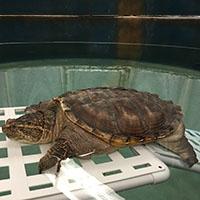What to do if you found a snapping turtle
About Snapping Turtles

Snapping turtles vary considerably in size depending on their age. These turtles can live for decades and become quite large (up to 30 lbs.). While snapping turtles are often thought of as aggressive predators, these turtles, in fact, are omnivores whose diet consists partly of plant matter. Snapping turtles spend most of their time underwater waiting for their next snack to float by. They are not aggressive animals, but like any wild animal, they will defend themselves if they feel threatened.
Identifying Snapping Turtles

Snapping turtles are easily recognized by their dark carapace (upper shell) with a deeply serrated back margin and a small plastron (bottom shell) that does not completely cover all of the animal’s flesh. Three low keels (or ridges) on the carapace of younger turtles often become obscure as the turtle matures. The carapace measures 8-12 inches on an average adult, and the turtles can weigh between 10-35 pounds. The carapace can vary in color, from green to brown to black; sometimes it is covered with moss. Snapping turtles have a long tail, often measuring as long or longer than the carapace, that is covered with bony plates. They also have a large head, long neck, and a sharp, hooked upper jaw. This hard beak has a rough cutting edge that is used for tearing food.
- Identification and life history information of the common snapping turtle
- Snapping turtle nesting in your yard
Common Reasons We Find Snapping Turtles
Snapping turtles are most often encountered during mating and breeding season when they come out of the water and can travel a considerable distance over land. Females may be seen laying eggs in your yard.
- General advice about turtles crossing roads
- General advice about what to do if you find a sick or injured turtle
Advice About Handling and Transporting Injured Snapping Turtles
-
Snapping turtles have powerful jaws and long necks. They can extend their necks rapidly.

- Do not place your hands near the front half of the turtle.
- Do not pick the turtle up by the tail, as you can injure the bones of the tail and back.
- If you have an appropriately sized box or container, try to gently push the turtle into the box from behind. If you have an object such as a broom or a shovel, you can carefully use this to nudge the turtle into the box.
- If you are moving the turtle across the road gently tip the turtle out of the box on the other side of the road.
- If you do not have or cannot get the turtle into a box, you can pick the turtle up by the top shell by placing your hands above each BACK leg. The claws on the feet are very sharp, however, and can cause deep scratches on your hands and arms. Use gloves if you have them. If you don’t have gloves, a towel, a sweatshirt, or a jacket can be placed over the back end of the turtle before you pick it and will protect your hands from the claws.
Transport
If the snapping turtle is injured and you cannot transport it to Tufts Wildlife Clinic immediately or if the Clinic is not open, keep the turtle in a warm, quiet place in the tightly sealed container with proper breathing holes until you are able to bring it to the Clinic.
For further assistance on Transport, please refer to the "Who to Call for Help" section on this page.